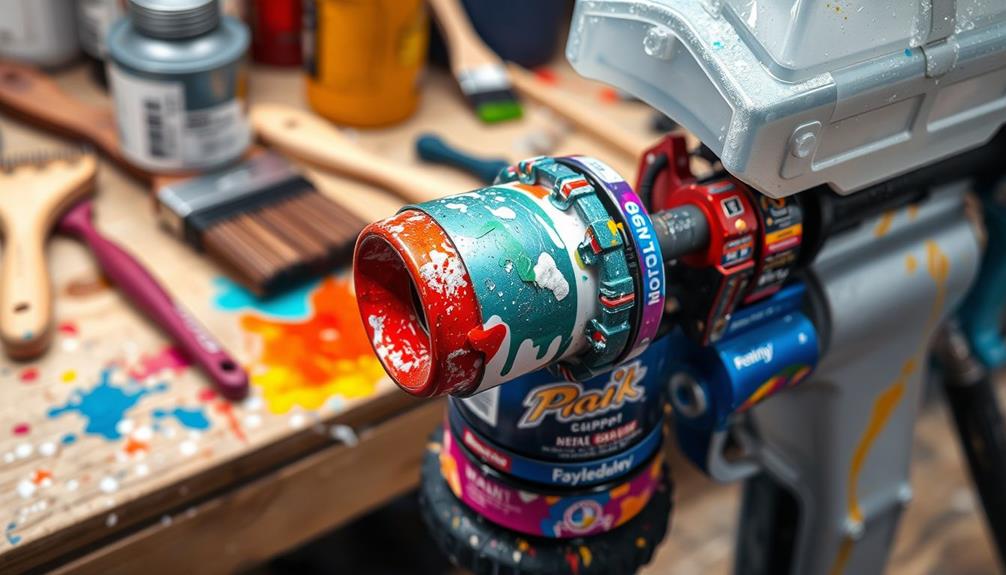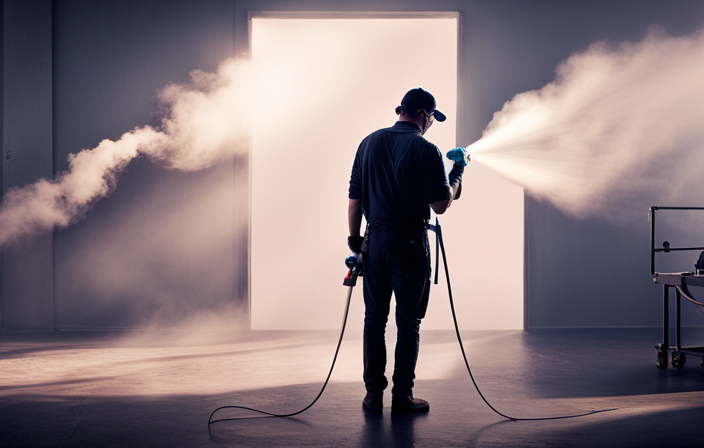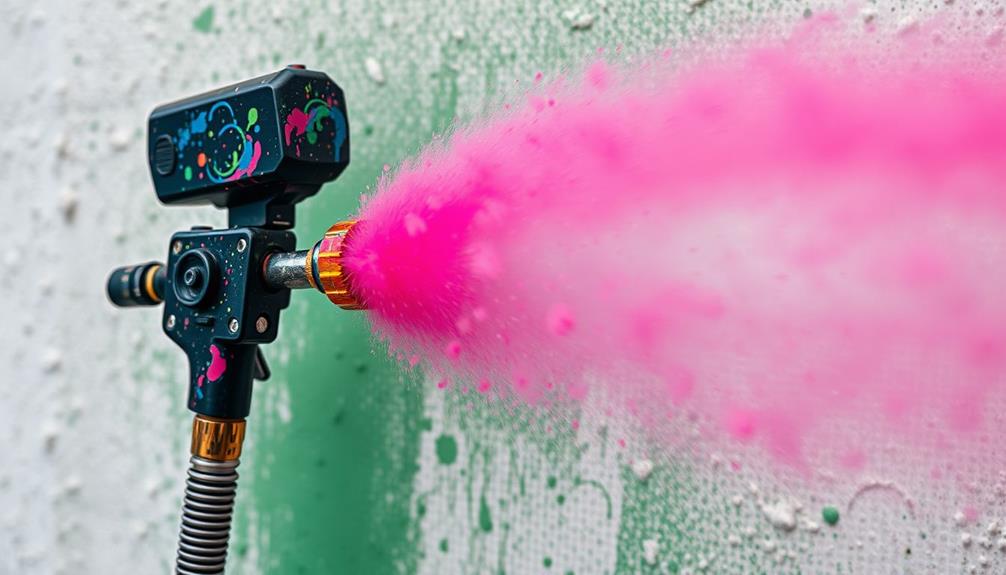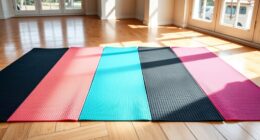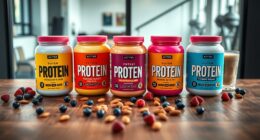To keep your airless paint sprayer in top shape, regular maintenance is essential. Start by flushing the system with water or mineral spirits after each use to prevent dried paint from causing damage. Inspect and clean your pump inlet strainers and filters frequently to avoid clogs. Always clean your spray tips and replace them every 15-40 gallons of latex paint. Store your sprayer in a dry, temperature-controlled spot, and use protective covers to shield it from dust. By following these tips, you'll enhance its performance and longevity, and there's even more to explore for peak care.
Key Takeaways
- Regularly flush the system with water or mineral spirits after each use to prevent dried paint buildup.
- Inspect and clean filters, spray tips, and pump inlet strainers frequently to avoid clogs and maintain performance.
- Conduct daily exterior cleaning of hoses using brushes and rags to ensure flexibility and prevent damage.
- Store your sprayer in a dry, temperature-controlled environment and apply pump-preserver for optimal protection during cold storage.
- Replace worn components and conduct regular inspections to catch small issues before they escalate into costly repairs.
Importance of Regular Maintenance
Regular maintenance of your airless paint sprayer is vital for keeping it in top shape. By prioritizing proper care, you can extend the lifespan of your equipment and avoid costly breakdowns that disrupt your projects. Neglecting the maintenance of your paint sprayer can lead to severe damage, such as dried paint on pump rods, which might require expensive repairs.
To guarantee peak performance, it's important to take into account maintenance and cleaning tips that can easily be integrated into your routine.
To prevent these issues, make daily cleaning and maintaining a part of your routine. Regular inspections help catch small problems before they escalate, guaranteeing consistent performance on job sites. Additionally, replacing worn components like spray tips and filters is essential for maintaining peak efficiency and quality in your paint application.
Engaging in these maintenance practices not only enhances your airless sprayer's performance but also saves you time and money in the long run.
Remember, a well-maintained spray gun is key to achieving smooth, professional results. By investing effort in the upkeep of your equipment, you'll guarantee it operates at its best, allowing you to focus on delivering excellent work without unnecessary interruptions.
Commit to regular maintenance, and you'll see the benefits in every project you tackle.
Effective Cleaning Procedures

To keep your airless paint sprayer in prime condition, implementing effective cleaning procedures is crucial. After each use, regularly flush the system with water or mineral spirits to clear out paint residues and prevent material buildup in pump pockets and cracks. This simple step guarantees smooth operation during your next project.
Additionally, using the right oil for lubrication can greatly enhance your sprayer's performance and longevity, guaranteeing that all components remain in peak condition. Proper maintenance practices, such as following recommended dilution guidelines, can also aid in achieving ideal results.
Utilize specific cleaning tools for thorough maintenance:
- Use a bottle brush for hard-to-reach pump areas.
- Clean the spray tip with a solvent-soaked brush.
- Meticulously clean filters, tips, and valves to avoid clogs.
Every day, conduct an exterior cleaning of hoses with water or mineral spirits, and flush the interior to maintain flexibility and prevent paint from hardening inside.
Avoid using a water hose for cleaning your sprayer; instead, rely on brushes and rags to effectively remove overspray and debris while protecting the equipment.
Component-Specific Care
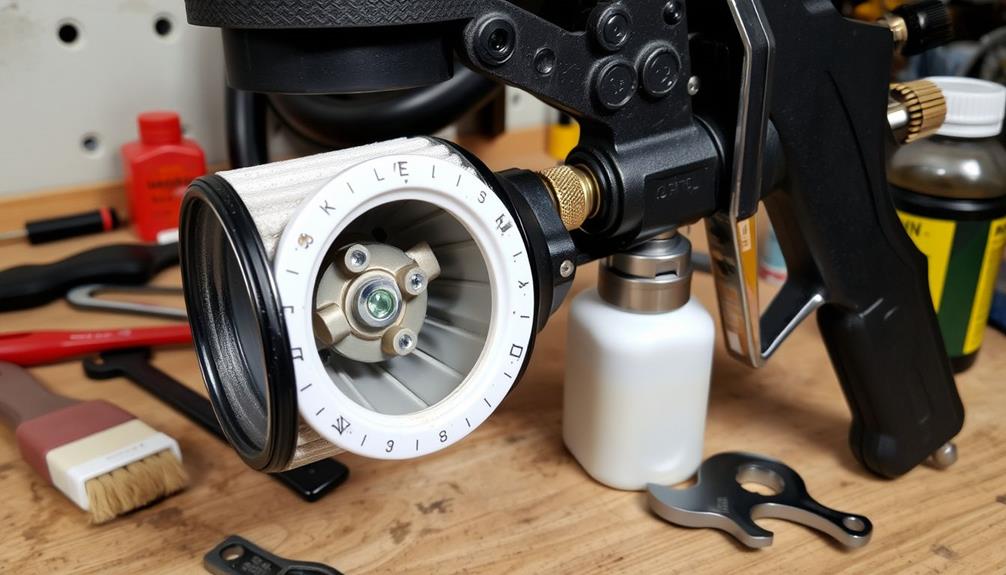
Maintaining your airless paint sprayer goes beyond cleaning; it involves paying attention to specific components that can affect its performance. Regularly inspecting the pump inlet strainers for dried paint or debris is vital. If you notice any buildup, clean or replace them to guarantee peak paint flow and prevent clogs.
Additionally, choosing a reliable cleaning service can help you keep your workspace tidy, which is essential for maintaining equipment best vacuum expert.
Next, check the throat packing wet cup for leaks. Tighten it if necessary to maintain a proper seal and prevent paint leakage.
The spray tips also need your attention. Clean or replace them every 15-40 gallons for latex paints and every 35-60 gallons for oils and stains. This practice helps avoid excess paint usage and guarantees a consistent spray pattern.
Don't forget to inspect and clean filters frequently. This keeps clogs at bay and maintains smooth operation, and you should replace them when necessary to avoid performance issues.
Finally, make sure that drain tubes are free from clogs. Replace them if damaged to prevent paint buildup and guarantee proper drainage after use.
Storage Best Practices
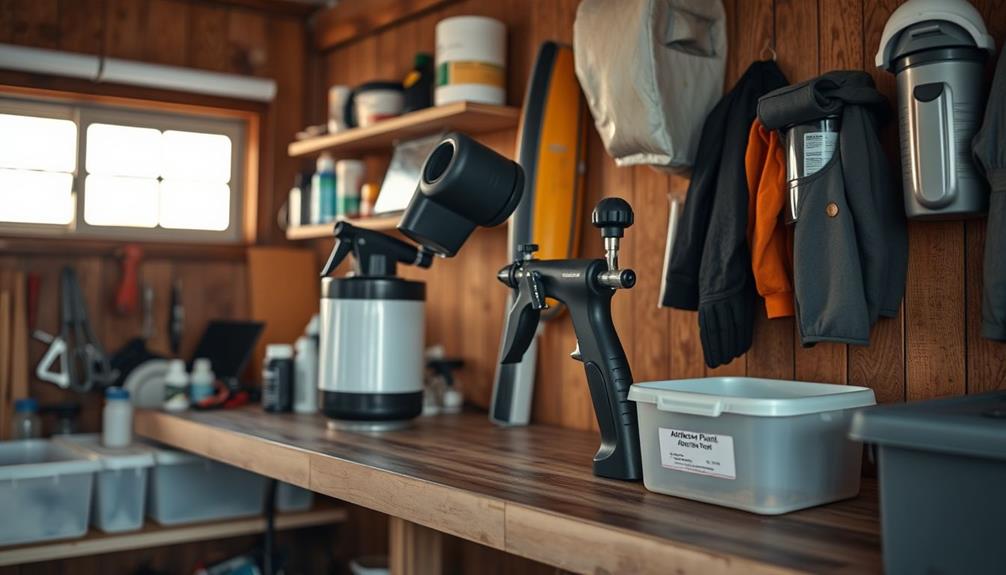
Proper storage of your airless paint sprayer is vital for preserving its longevity and performance. To keep your sprayer in top shape, follow these best practices.
First, make certain you perform a final flush to remove any latex paint or residue from the system. This step is essential as a well-maintained sprayer can greatly deter potential issues, much like how home security systems protect against intrusions.
After flushing, confirm all components, including hoses and filters, are cleaned and dried thoroughly. This prevents paint residue from hardening and causing blockages.
Next, store your airless paint sprayer in a dry, temperature-controlled environment. Avoid exposing it to moisture or extreme temperatures that could damage the equipment.
Using protective covers is also a smart idea, as they shield the sprayer from dust and debris accumulation during periods of inactivity.
Lastly, consider applying a pump-preserver like mineral spirits to protect internal components from freezing and corrosion if you're storing the sprayer in cold conditions.
- Keep your sprayer in a dry, controlled environment.
- Make sure to clean and dry all components before storage.
- Regularly check for signs of wear or damage.
Troubleshooting Common Issues

Common issues with airless paint sprayers can disrupt your painting projects, but many of these problems are easily fixable. If you're experiencing uneven spray patterns, start by adjusting the pressure settings. Also, make sure the spray tip is clean and free of clogs. A clogged tip can greatly affect your results, similar to how air purifiers improve indoor air quality by eliminating pollutants.
If your sprayer fails to operate, check for blockages in the hose, filters, or spray gun. These are common culprits behind operational issues.
Additionally, if you hear unusual noises during operation, it may indicate mechanical problems. Inspect the pump and motor components for any wear or damage.
You might also notice gun spitting or dribbling, which signals potential wear in the spray tip or packing. Replacing these parts promptly helps maintain consistent performance.
For specific error codes or warnings, always refer to the user manual. It provides guidance on troubleshooting various issues that may arise with your airless paint sprayer.
Frequently Asked Questions
What Is the Number One Rule When Using Airless Spray Guns?
The number one rule when using airless spray guns is to maintain a consistent distance of 12 to 18 inches from the surface. This guarantees even application and helps you avoid overspray for a cleaner finish.
How to Maintain an Airless Sprayer?
To maintain your airless sprayer, regularly inspect and clean it, replace spray tips as needed, and conduct daily maintenance. Proper storage and using pump-preservers during cold weather will keep it in great working condition.
Can You Leave Paint in an Airless Sprayer Between Coats?
You shouldn't leave paint in an airless sprayer between coats. If you must, cover it and limit the time to a few hours. Always flush the system before and after breaks to prevent clogs.
What Is the Best Tip for Airless Paint Sprayer?
When choosing the best tip for your airless paint sprayer, consider the paint's viscosity and desired finish. Typically, tips between 0.011 to 0.017 inches work well for most applications, ensuring efficiency and quality.
Conclusion
By keeping up with your airless paint sprayer's maintenance, you're not just prolonging its life; you're ensuring every project runs smoothly. Think of it like tuning a musical instrument—just a little care and attention can turn a dissonant experience into a symphony of flawless finishes. So, whether you're cleaning it after a job or storing it properly, remember that these small actions lead to big results. Your sprayer deserves that extra love to keep creating beautiful spaces.
